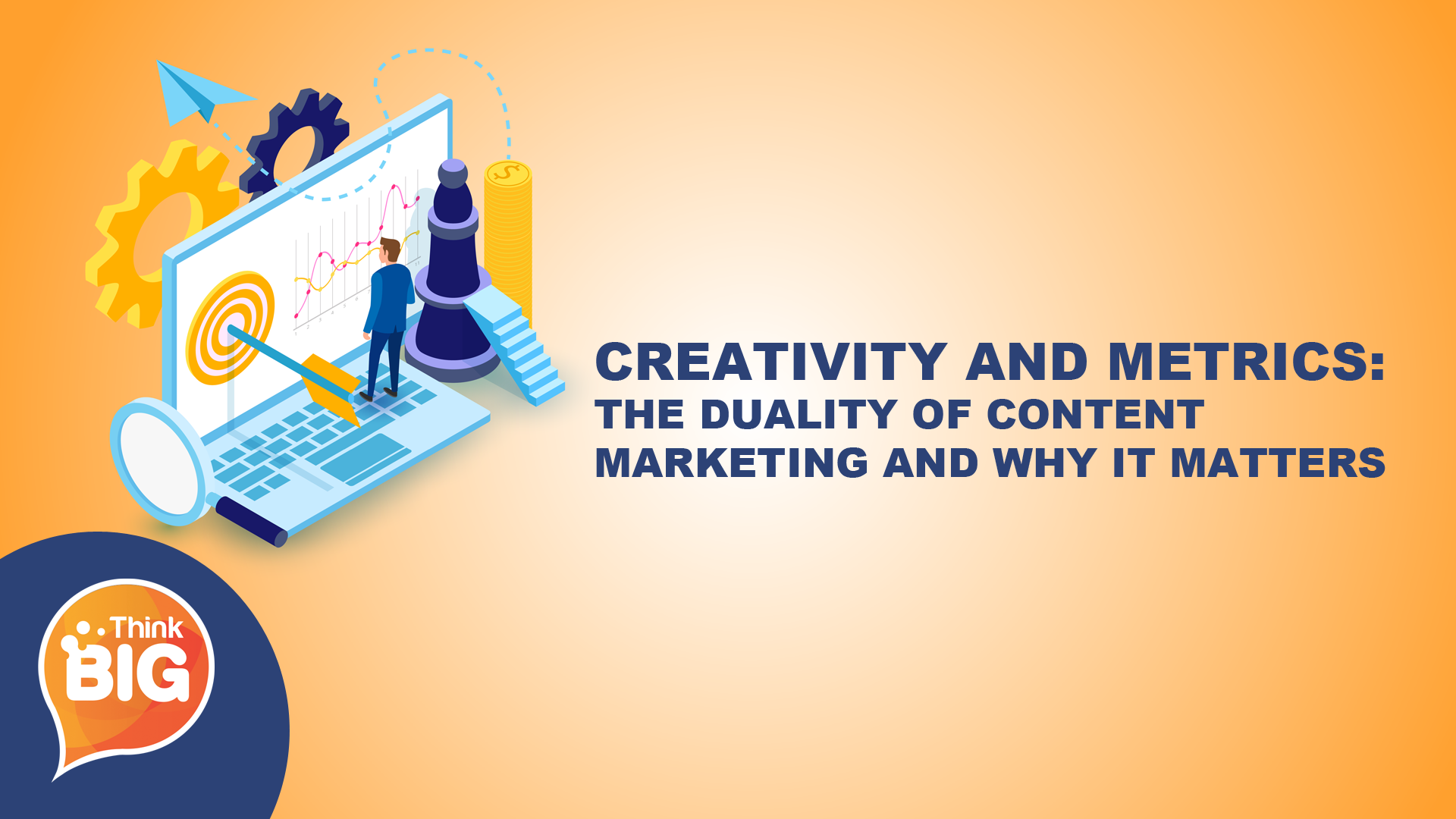
If you’ve been a part of the digital marketing community for some time, you’re likely pretty familiar with the basics of content marketing.
There are plenty of debates that marketing experts and business owners have:
- Which method of promotion works best?
- What’s the best way to create a targeted marketing strategy?
- Which social media platform works best for X demographic?
And while there are plenty more, no issue is as hotly debated as the argument of creativity versus metrics.

On one hand, you have the people who swear by creativity in their marketing efforts and claim that it’s the secret to their success.
On the other, you have marketing experts who stand by the idea that copy and content doesn’t matter. It’s all about the analytics and promotion.
To make matters worse, it seems like every six months, some new study comes out, assuring one side that they were right all along.
And while you might have your own ideas on the matter, it’s easy to see why so many people are confused on the issue.
That’s why today, we’ve decided to explain, once and for all, which of these two marketing components is truly worth your time and energy.
By the time we’re done here, you won’t just walk away with an answer. You’ll be armed with all the tools you need to create a top-notch marketing strategy, no matter what industry you’re in.
So, let’s dive in and take a look at creativity and whether or not it actually helps your business.

Creativity and What It Means For Your Business
Now, let’s get one thing out of the way.
When we say ‘creativity’, we’re not talking about poetry or some sort of brilliant work of art. Creativity as it relates to content is all about how authentically you can convey your message to your audience.
It’s easy to understand why some people might be scratching their head at this idea. When you’re selling hiking gear or usb drives, why should you have to worry about anything other than creating an amazing product?
Well, to understand that, we have to go back in time to the 1970s.
Before we had social media ads and PPC, we had television spots and radio commercials.

And for a while, the idea wasn’t to simply state the benefits of your product. The biggest names in the world were using their ad space to create cultural movements and iconic images that would stay with audiences long after they turned their TVs off.
Fast forward to today and things have changed pretty significantly. The consumer is significantly more informed (and a touch more cynical), and there are more ways to reach out to audiences than ever before.
That being said, the root of marketing is still defined by two things. At a basic level, your job is to turn attention into a sale.
But how you get that attention is up to you. And make no mistake, with more competitors than ever before, you’ll need to something particularly impressive to stand out.
That’s where creativity comes in.

You’re not trying to create a catchy jingle or ad. You’re looking for a way to connect with your audience.
You want your content to be impossible to look away from. It needs to demand attention, one way or another.
Are there companies that go the artsy route? Absolutely, and it’s likely one of the reasons brands like Apple have done so well.
But if the inspiration isn’t there, there’s no reason that you should force your business to be something it isn’t.
If you’re selling hiking equipment, you can easily create authentic hiking content without having to reinvent the wheel every week.
How do you pull that off? Well, you start by understanding how to create compelling content consistently and effectively.
Our advice? Start by determining whether you’d like to focus on educational or entertaining content first.
Typically, the answer here is pretty obvious. If you have to ask which is best for you, the answer is probably educational.

Creating entertaining content can be particularly tricky, but massively successful if done properly.
Out of the two options you have, educational content is a much safe choice because it’s just so difficult to get wrong once you have all the right pieces in place.
All of this brings up some important questions. What makes educational content so compelling? And if it’s so easy, how does one actually go about making it?
Well, before you can understand any of that, you first need to look at how educational content itself is broken down.
At its core, all content has to offer value in some way, shape, or form. The more value you’re able to offer audiences, the more likely you are to capture their attention.
The term ‘value’ is one that tends to trip up a few small business owners, and understandably so.

“But my products/services already offer value,” they might say. “Why on earth would I need to offer more than that?”
Well, in an ideal world, we wouldn’t have to. But with dozens of competitors in your industry and a crowded marketing space, sometimes we have to go above and beyond to make that sale.
If that seems confusing, just imagine two restaurants. They both serve sushi, but one of those restaurants makes every effort possible to accommodate you.
Which are you more likely to go back to? The one where you walked away with more value.
For the sake of simplicity, we’ll refer to the first and most common form of educational content as ‘tangible solutions’.
The idea behind tangible solutions is relatively straightforward. The way you offer value isn’t by creating a funny ad, but by offering a solution to your audience’s problems.
In fact, you’re going a step beyond just giving them some advice. You’ve put together a piece of content (video, infographic, blog post, etc.) that walks them through the process of fixing a specific issue they have.
By the time they’re done with that piece of content, they can walk away and apply that solution immediately.
In other words, they’ve walked away with significantly more value than they anticipated. And that’s the cornerstone of attention in this constantly changing digital marketing ecosystem.
The other kind of educational content is a bit less common, but no less effective.
“Thought leadership” content is when you tackle large, overarching issues that plague your audience.
More often than not, audiences are dealing with issues that are the result of a much larger problem.
Now, there’s nothing wrong with giving audiences actionable, tangible steps to solving their issues.
But there’s a difference between treating a symptom and treating the illness. The reason thought leadership content performs so well is because it can open someone’s eyes and help them reimagine a particular industry.

Metrics and How They Elevate Your Business
Still, that was just one side of the story. And if we’re hoping to end up with a real answer here, we need to understand how analytics and data relate to your marketing efforts.
Right off the bat, let’s get one thing clear: the most brilliant creative copy on the planet isn’t going to do anything for your brand if no one can see it.
Visibility is what makes or breaks businesses, there’s no way around it.
So, what does that look like in the digital marketing ecosystem? Well, the first issue your business will have to deal with is the proper application of SEO and keywords.
If you’re still unsure about these terms, here’s the easiest way to think about them: keywords are one of the many languages that your website uses to communicate with Google.
SEO is all about making sure that Google gets the messages your site is sending.
Simple enough, right?
Well, yes and no.
One of the most problematic aspects of SEO and keyword research is that Google isn’t exactly transparent about what helps your business succeed online.
But there are a few key lessons we’ve been able to learn over the years.
First off, having no SEO simply isn’t an option. At some point, you need to research what words are relevant to your industry and how well those words are ranking on Google.
Of course, that’s just the tip of the iceberg. You’ll also need to understand terms like long-tail keywords, UX, site optimization and much more to get a complete picture.
But make no mistake: a well optimized site will almost always receive more traffic (and by extension, more conversions) than a site with poor SEO.
All of which actually brings us to the main lesson you should walk away with today: there is no scenario where you get to pick metrics or creativity.
If you want to run a successful marketing campaign, you’re going to need both.

Conclusion
Creativity and analytics are, despite what many might believe, two sides of the same coin.
Remember: the basic principle of marketing is turning attention into a sale. But if you’re serious about maximizing your attention and increasing sales, you can’t afford to bet on just one method.
The online marketplace competition is fierce, and if you’re planning on becoming an online authority, you’re going to need every tool at your disposal.
The only real option is which of these two marketing principles are going to take priority for you. And that’s going to come down to how well you know your audience and your niche.
Creativity might seem intimidating if you haven’t written an essay since college, but there’s no need to make things too complicated here.
Use your industry experience and strong understanding of customer pain points to create content that you know will help your audience.
Make them laugh, make them learn, but no matter what, make sure that they walk away with something memorable.
As far as metrics go, there are plenty of ways that you can make things easier on yourself if you’re not an ‘analytics’ person.
Automated tools, like Hubspot, can simplify the process significantly and help you turn all that raw data into something you can use to create a data-driven piece of content.
At the end of the day, all that matters is that you find a way to draw people attention to your business and move them from the ‘maybe’ column to the ‘yes’ column with your compelling, engaging content.

